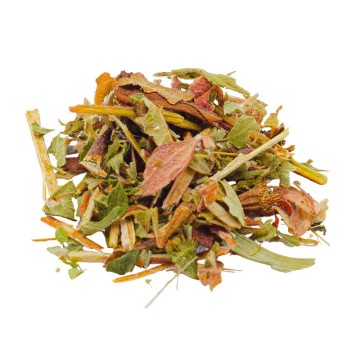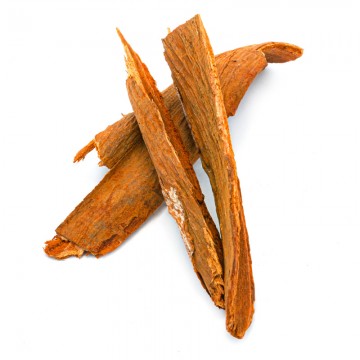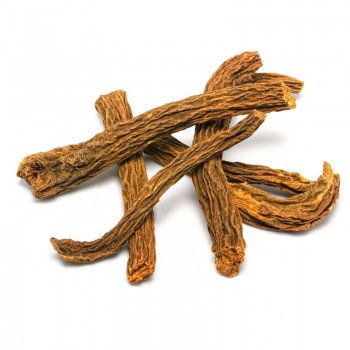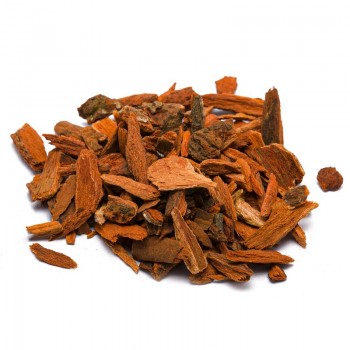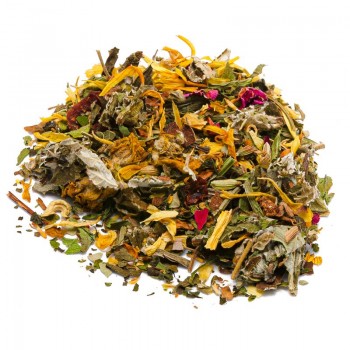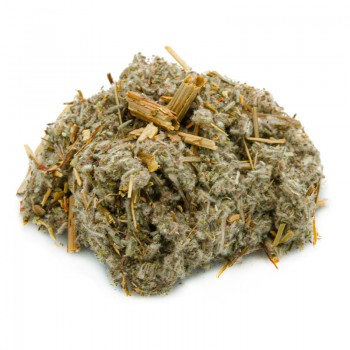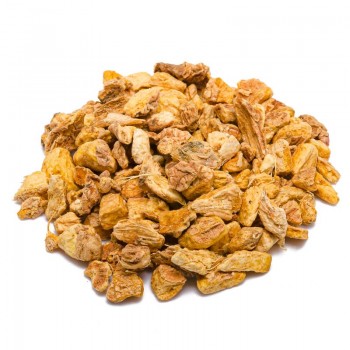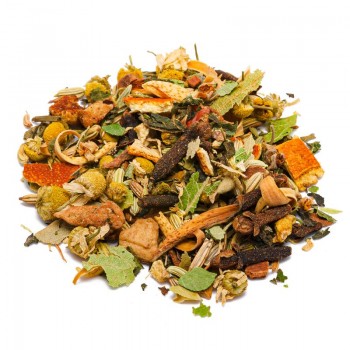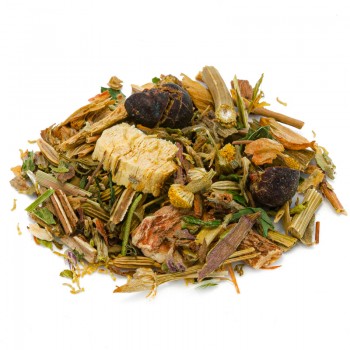Heartburn can be very annoying, causing several problems after digestion, and continuously irritating the gastric walls. It is a condition that occurs when stomach acids leak into the esophagus.
While it can sometimes be occasional, in some cases it occurs frequently, with heartburn sometimes associated with pain. In the most annoying conditions, it can also lead to coughing, nausea, frequent belching.
The most known reason for heartburn is bad eating habits, excessive consumption of acidic foods, or the use of drugs, abuse of smoking, alcohol and carbonated drinks.
Some herbal teas are an effective remedy for stomach acidity, improving the conditions of this imbalance and alleviating its symptoms. This herbal blend for stomach acidity is a natural remedy to calm irritation and provide relief from gastritis and heartburn.
The chosen herbal tea mix contains herbs and vegetables such as: anise, fennel, mint, marjoram, lemon balm, southernwood, angelica, raponticum.
Herbs useful in case of gastritis and acidity: properties and benefits
A herbal tea can help reduce stomach acid, thanks to the right ingredients.
Some herbs have soothing properties for the stomach and esophagus, helping the stomach lining to feel good and relieving excess gas. Others promote hydration,
These herbs in heartburn tea are an excellent resource for dealing with acid reflux as well.
The key ingredient is fennel, a great treatment for those suffering from reflux and heartburn. It is a basic herb and not acidic, which can help reduce the discomfort caused by acid reflux.
Its nature neutralizes stomach acid, while nourishing the digestive system properly. It has natural anti-inflammatory properties, to reduce irritation and swelling in the digestive tract.
Anise, an aromatic plant very similar to fennel in its effects, has properties useful for combating ulcers and heartburn and spasms, indigestion, nausea and intestinal gas. Some gastric ulcers are an unwanted consequence of heartburn, since the mucosa of the wall is damaged by prolonged exposure to the acid of the esophagus. In this way painful ulceration is born, and anise is one of the natural remedies to relieve stomach irritation and ulcers, with a gastroprotective property on the mucosa. In addition, anise in herbal tea soothes the symptom of spasms or stomach pain, relieves irritation and fights indigestion - one of the main causes of heartburn.
Another ingredient of the digestive herbal tea is marjoram, known for its beneficial properties on the digestive system. It is a gastroprotective herb, which counteracts stomach acidity and stimulates digestion. - it also works by increasing digestive enzymes and saliva. It calms some gastric symptoms such as painful cramps or stomach spasms.
Mint is an ingredient that must be dosed carefully, since too much mint in the herbal tea can worsen the gastric condition. In our blend for stomach acidity, it becomes refreshing and decreases irritation in the digestive system; it calms pain and prevents gastroesophageal reflux.
Mint leaves have strong digestive enzymes that reduce the burning sensation in the stomach, speed up digestion and relieve stomach problems.
Melissa tones and strengthens the stomach, promoting the correct digestive process, also regulating the flow of gastric juices. It is known for its natural healing properties for stomach ulcers.
Angelica is a medicinal herb excellent for soothing conditions of latent gastritis, with occasional stomach pain and digestive difficulties. Its tonic and digestive action counteracts nausea, irritation and calms stomach pain. It acts against gastric disorders accompanied by acidity or hypoacidity, and is useful in cases of indigestion.
Southernwood is included in the herbal mixture for stomach acidity, for its characteristics that strengthen the stomach and promote digestion. It is aan herb rich in digestive bitter substances and tannins, also considered useful in the past as a natural antiseptic and vermifuge.
In this digestive herbal tea, rapontico plays a laxative and digestive function, often combined with fennel, to avoid intestinal pain. Defined as “false rhubarb”, it has stomachic and tonic properties for digestion.
Origins and History of Cultivation
In the mixture of herbs for gastric protection, we find medicinal plants of various origins, but for the most part known for centuries in herbal medicine. Their beneficial action on the stomach and digestive system is known, and various herbs are used individually, as well as in mixtures for stomach acidity and gastritis.
Most medicinal herbs have been widespread since ancient times in European territory, while rhubarb is a more recent acquisition in phytotherapy – being of Asian origin and probably imported in the 16th century.
Plants and flowers
The components of the mixture for stomach acidity are various, deriving from medicinal plants or shrubs known for their properties.
The southern woodland, with the botanical name Artemisia abrotanum, is a perennial plant of the Compositae family. It originally grows in southern Europe, and is known for its cedar-like odor. It grows best on uncultivated land, and reaches a height of about 1 meter. It has been used for centuries in herbal medicine, was already appreciated by the ancient Greeks, and was widespread in the Middle Ages.
The fennel or Foeniculum vulgare, is a plant of the Apiaceae (Umbelliferae) family. It originally grew on the Mediterranean coasts, although today it is widespread in many parts of the world, for its food value. It prefers arid lands, near the sea and on the banks of rivers.
Mint or Mentha is a perennial plant of the Lamiaceae family. It is widespread with different varieties, up to 24 species, all with similar herbal properties. Many hybrids of mint are renowned, mainly used for food.
Rhapontic or Rheum Rhaponticum is a herbaceous species belonging to the Polygonaceae family. It is a perennial plant whose name derives from the Latin rapòntico, a composition of rha, rhubarb, and Pontus (i.e. the Black Sea). Native to Central Asia, the rhapontic is characterized by the yellow rhizome with deep roots, from which a rosette of large oval leaves develops. The stem can reach 2 meters and produces small, white flowers.
anise has the botanical name of Pimpinella anisum, an annual plant belonging to the Umbelliferae family. It is one of the oldest medicinal plants, reaching 30-50 cm, with small white flowers and small seeds, from green to yellow.
Angelica Archangelica is a plant of the Apiaceae/Umbelliferae family, which grows spontaneously in mountain areas, in woods and in humid soils.
It is also known as Angelica officinalis, and is widespread especially in Europe. It is cultivated for its edible stems and roots, reaching a height of up to 2 meters. It produces large leaves and small, numerous, greenish-white flowers.
Melissa officinalis is an annual plant of the Lamiaceae family. Native to southern Europe, it grows up to about 60 centimeters in height, and flowers from June to August. It grows best in soil exposed to full sun, giving white or pale yellow flowers, and very aromatic leaves.
Marjoram, botanical name Origanum majorana, is a perennial plant of the Lamiaceae family, also known as Persia. Typical of the temperate climate, it can grow up to about 60 centimeters in height. It grows spontaneously along rocky places, dry slopes and up to over 2,000 meters high in some regions.
Nutritional values of the calm stomach herbal blend
This mix for stomachic herbal tea contains various active ingredients for the protection of the stomach and to aid digestion.
This herbal blend makes available phenolic compounds, tannins and antioxidants useful for gastric protection. Some important substances are anethole, phencione, estragole, quercetin,rutin and gallic acid. Vitamins and mineral salts are also present.
How to use the herbal blend in the herbal tea for stomach acidity
The infusion is obtained by placing in a cup (250 ml), about 3-5 grams of the herbal blend for gastric protection, with water at 100 °C.
Leave to infuse for 8 to 10 minutes, before drinking the herbal tea.
Add honey or sugar, if desired.
Herbal blend for a calm stomach: side effects and contraindications
Among digestive herbal teas, this blend does not have major contraindications.
In any case, it is not recommended for people who are sensitive to individual ingredients, with allergies or intolerances to individual ingredients. It is recommended not to take the gastroprotective herbal tea for long periods and to respect the recommended doses, to avoid diarrhea, nausea, photosensitivity.
Due to the presence of substances that act on the digestive system, it is advisable to seek medical advice for those who suffer from ulcers, esophagitis and gastroesophageal reflux.
It is also useful to seek advice in case of taking oral contraceptives, which could interfere with the phyto-estrogens of anise.
The herbal tea is not recommended for pregnant or breastfeeding women.





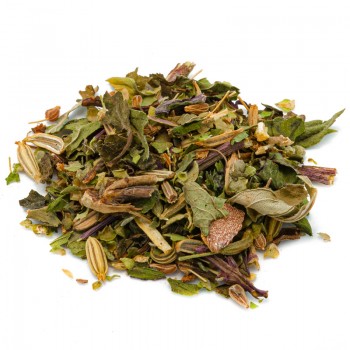



 No reward points for this product.
No reward points for this product.
